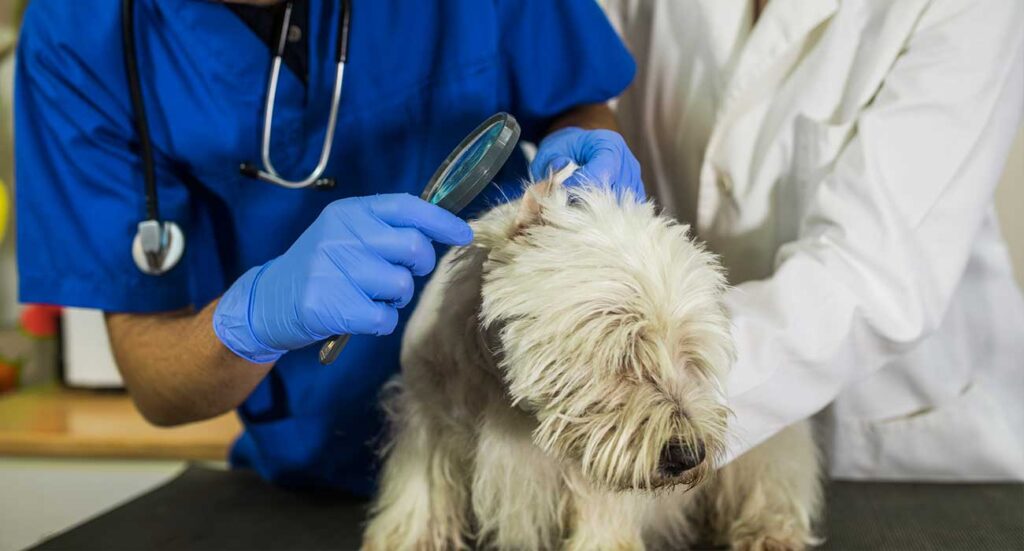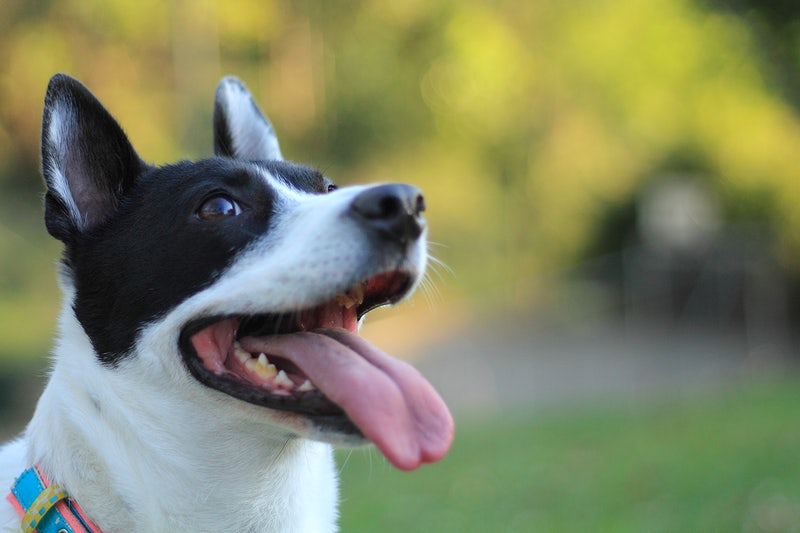What Do Flea Bites Look Like on Dogs? Symptoms and Treatment
What Do Flea Bites Look Like on Dogs? Symptoms and Treatment
If you’re like most dog owners, the sound of your dog scratching herself is music to your ears. However, if that scratching becomes more deliberate and urgent, it might be time to investigate what’s causing it. In this blog post, we’ll discuss what do flea bites look like on dogs so that you can be sure whether or not your pet needs treatment.
What Are Dog Fleas?

Fleas are small, brown insects that live off the blood of mammals and birds. They are a major nuisance to pet owners because they can cause severe itching and skin irritation in both dogs and cats.
Fleas can also transmit diseases to pets, including bartonellosis and mycoplasma haemofelis.
In addition, fleas can infest homes and yards, making it difficult to get rid of them. Unfortunately, fleas are very common in most parts of the world and can be difficult to control. The best way to prevent flea infestations is to use monthly flea treatments on your pets and keep them away from areas where fleas are known to live.
What Do Flea Bites Look Like On Dogs And What Are The Symptoms Of A Flea Infestation

What Do Flea Bites Look Like on Dogs? Flea bites on dogs typically appear as small, red bumps. They may be clustered together or scattered around the dog’s body and may be accompanied by severe itchiness.
In some cases, flea bites can also lead to hair loss, hot spots, and secondary infections.
A flea infestation is often characterized by a sudden onset of itching and biting, followed by the appearance of flea dirt (small, black dots) on the skin.
If you suspect that your dog has a flea problem, it is important to consult with a veterinarian for proper diagnosis and treatment.
Flea Bites Can Cause A Lot Of Irritation And Discomfort For Dogs

What Do Flea Bites Look Like on Dogs? Flea bites can not only be irritating and itchy for your dog, but they can also lead to flea bite scabs. These flea bite scabs are caused by the dog’s scratching and biting at the fleabites, which then leads to secondary infections.
The flea bites usually occur on the dog’s belly, legs, and neck areas where the fleas can easily access the skin. In severe cases, flea bites can also cause anemia in dogs.
If you suspect that your dog has fleas, it’s important to take them to the vet right away for treatment. In the meantime, there are a few things you can do to help alleviate your dog’s discomfort. First, keep them well-groomed by regularly brushing their fur. This will help to remove any loose fleas or flea eggs.
You can also try using a flea comb to help catch and remove any fleas that are currently on your dog. Finally, give your dog a bath with warm water and mild soap to help soothe their skin and reduce irritation.
The Symptoms Of Flea Bites Can Vary Depending On The Dog

What Do Flea Bites Look Like on Dogs? Flea bites on dogs can cause a variety of symptoms, ranging from mild irritation to serious illness. The most common symptom is itching, which can be intense and persistent.
Some dogs also develop a rash or hives at the site of the bite, and some may experience swelling. In more severe cases, flea bites can lead to anemia or even death.
Fortunately, there are several treatments available to help relieve your dog’s symptoms and keep fleas under control. If you think your dog has been bitten by a flea, be sure to consult your veterinarian for the best course of action.
How To Treat Flea Bites On Dogs – Topical Treatments, Oral Medications, And Home Remedies

Fleas are a common nuisance for dogs and their owners alike. Not only are these pesky creatures a source of irritation for our furry friends, but they can also transmit harmful diseases. And when fleas bite, they can cause itchiness, redness, and swelling.
If your dog has been bitten by a flea, it’s important to take quick action to treat the bites and prevent further irritation.
There are a few different options for treating flea bites on dogs. Topical treatments like ointments or creams can help to soothe the bites and relieve itching.
Oral medications may also be prescribed by your veterinarian in some cases. And there are a few simple home remedies that can be used to ease your dog’s discomfort.
To start, you’ll want to inspect your dog’s fur for any signs of fleas or flea dirt. If you see any evidence of fleas, you’ll need to take steps to eradicate them from your home and yard. Once the fleas are gone, you can begin treating your dog’s bites.
If the bites are mild, you may be able to treat them at home with over-the-counter medications or home remedies. For more severe cases, you may need to take your dog to the vet for treatment.
In either case, it’s important to keep an eye on your dog for any signs of infection and consult your veterinarian if you have any concerns.
If Your Dog Is Showing Signs Of A Flea Infestation, It’s Important To Take Action Quickly

Fleas are one of the most common problems that dog owners face. Not only are they a nuisance, but they can also cause a range of health problems for your pooch. If you suspect that your dog has a flea infestation, it’s important to take action quickly.
The first step is to assess the situation. Look for signs of fleas, such as biting, scratching, and excessive licking or biting. If you see any of these signs, it’s time to take action. The next step is to treat your dog with a topical spot-on treatment or oral medication.
Be sure to follow the directions carefully and avoid using too much or too little of the product. Finally, it’s important to vacuum your home thoroughly and wash all of your dog’s bedding in hot water.
By taking these steps, you can help to get rid of fleas quickly and keep your dog healthy and happy.
What To Do Once You’ve Confirmed Your Dog Has Fleas

If you’ve discovered fleas on your dog, it’s important to take immediate action.
While a few fleas may not seem like a big deal, they can quickly multiply and cause your pet a great deal of discomfort. Additionally, fleas can transmit diseases to both dogs and humans.
Fortunately, there are a number of steps you can take to get rid of fleas and prevent them from coming back.
The first step is to treat your dog with a flea preventative. There are a variety of options available, so talk to your veterinarian to find the best one for your pet.
Next, vacuum your home thoroughly, paying special attention to any areas where your dog spends a lot of time. Be sure to empty the vacuum after each use to prevent the fleas from escaping back into your home.
Finally, wash all of your pet’s bedding in hot water to kill any remaining fleas or their eggs. By taking these steps, you can get rid of fleas and help keep your home and pet free of these annoying pests.
How to Prevent Fleas From Biting Your Dog In The First Place

Fleas are a common nuisance for dogs and their owners alike. Not only are they uncomfortable for your dog, but they can also transmit diseases and cause allergic reactions.
The good news is that there are several things you can do to prevent fleas from biting your dog in the first place. Perhaps the most important thing is to keep your dog clean and well-groomed.
Regular bathing and brushing will help to remove any fleas that may be present and make it less likely for new ones to take up residence.
In addition, be sure to vacuum regularly and wash your dog’s bedding frequently. These simple steps will go a long way toward preventing a flea infestation.
What Do Flea Bites Look Like on Dogs? Do fleas only exist in dirty homes? Common Myths About Fleas And Dogs

Whenever we discuss, what do flea bites look like on dogs? We come across a number of myths. Fleas are a common problem for dog owners, but there are a lot of myths about these pesky parasites.
For example, many people believe that fleas only live on dirty dogs. However, fleas are actually attracted to all dogs, regardless of their grooming habits.
Another common myth is that fleas only bite humans if there are no other animals around. In reality, fleas will bite anything that they come into contact with, including humans, dogs, and even other animals.
Finally, some people believe that flea bites are not harmful to humans.
However, Flea bites can actually cause a number of problems for both humans and animals, including skin irritation and allergies.
If you think your dog has fleas, it’s important to consult a veterinarian to get the correct diagnosis and treatment. Ignoring the problem will only make it worse.
Conclusion
Flea bites on dogs are a common problem and can cause a lot of irritation and discomfort for dogs. The symptoms of flea bites can vary depending on the dog, but some of the most common symptoms include redness, inflammation, itching, and hair loss. There are several different topical treatments, oral medications, and home remedies that can be used to treat flea bites on dogs, but it’s important to take action quickly if your dog is showing signs of a flea infestation. Once you’ve confirmed that your dog has fleas, there are several steps you can take to get rid of them completely. You can also take steps to prevent fleas from biting your dog in the first place. Please leave a comment if you found this “what do flea bites look like on dogs?” post helpful.
FAQs About Fleas And Dogs
How do I control dog fleas?
Answer:
After getting an answer to the question, what do flea bites look like on dogs? One should be curious to control the dog fleas in the first place. There are a number of ways to control dog fleas, but the most effective method is to use a combination of prevention and treatment. For prevention, you’ll want to make sure your dog is on a monthly preventative such as Frontline or Advantix. This will help to keep fleas from being able to colonize your dog in the first place. In addition, you should also treat your home and yard for fleas using an insecticide designed specifically for fleas. This will help to kill any existing fleas and prevent new ones from moving in.
As far as treatment goes, if your dog does get fleas, there are a number of products available that can kill them quickly and effectively.
Can’t I just deal with a flea problem if it happens?
Answer:
After getting an answer to the question, what do flea bites look like on dogs? One should be curious if he or she can just deal with a flea problem when it happens. It is definitely best to take preventative measures against fleas if you can, as they can be a huge pain to deal with. Not only do they cause discomfort for your pet, but they can also infest your home and be difficult to get rid of.
There are a few things you can do to help prevent a flea infestation from happening in the first place. First, make sure that your pet is on a good flea prevention medication and that you are using it correctly.
Second, keep your home clean and free of debris where fleas could live and breed. Finally, check your pet’s bedding and toys regularly for signs of fleas or their eggs. If you do find an infestation, don’t hesitate to contact your veterinarian for treatment options.
What are the dangers of fleas?
Answer:
After getting an answer to the question, what do flea bites look like on dogs? One should be curious about the harm or dangers caused by fleas. Fleas are dangerous because they can transmit a variety of diseases to both humans and animals.
Some of the most common diseases transmitted by fleas include bubonic plague, typhus, and tapeworm.
Fleas can also transmit other diseases, such as bartonellosis, cat scratch fever, and rickettsiosis. In addition, fleas can also cause anemia in pets and humans.
Fleas are therefore a serious health risk and should be treated promptly if they are found in your home or on your pet.
What is the best treatment for dogs with Flea Allergy Dermatitis (FAD)?
Answer:
There are a number of different treatments that can be effective for dogs with Flea Allergy Dermatitis (FAD), and the best approach will often vary depending on the individual dog and the severity of their condition.
For milder cases, treatment may simply involve using a spot-on flea preventative medication and keeping the dog well-groomed to remove any leftover flea dirt or debris.
More severe cases may require more aggressive measures, such as oral or injectable steroids to reduce swelling and itching, antibiotics to treat secondary infections or even immunotherapy.
In most cases, though, treatment for FAD will require a combination of different approaches in order to be successful.
If your dog has been diagnosed with Flea Allergy Dermatitis, it’s important to work closely with your veterinarian to develop the best treatment plan for your pet.
What Do Flea Bites Look Like on Dogs? Do fleas only exist in dirty homes?
Answer:
No, fleas can exist in any environment – whether it be a clean or dirty home. However, they are more likely to thrive and reproduce in homes that are not clean since there is more food (i.e., dirt and debris) for them to feed on.
In addition, fleas can also hitch a ride into your home on your pets or your clothing, so even if you keep a clean house, you may still end up with these unwelcome guests.
What Do Flea Bites Look Like on Dogs? Do fleas only exist in dirty homes? How do I use my flea comb to check for fleas?
Answer: Use the flea comb to check your dog for fleas by parting your dog’s fur and running the comb through the fur, especially along the back and around the neck.
Check both the hair coat and skin for evidence of fleas, such as redness, irritation, or black specks (flea dirt). If you find any evidence of fleas, treat your dog with a topical or oral flea treatment.
What is the difference between IGRs (Insect Growth Regulators) and IDIs (Insect Development Inhibitors)?
Answer: Insect growth regulators (IGRs) are a class of insecticides that slow down the growth of insects, ultimately leading to their death. IDIs (insect development inhibitors) are a class of insecticides that prevent insects from developing into adults.
Both IGRs and IDIs work by disrupting the normal molting process of insects. Molting is when an insect sheds its old exoskeleton in order to grow larger. IGRs prevent insects from molting, which stunts their growth and leads to their death. IDIs prevent insects from developing into adults, which keeps them in the larval stage permanently and also leads to their death.
How long do fleas live for?
Answer:
Fleas can live for up to a year without a blood meal.
They generally live for around two to four months, but can last up to a year without food. However, they will die within two days if they do not have a blood meal.
What are ticks?
Answer: Ticks are parasitic arachnids that are known to bite and feed on the blood of mammals, birds, and sometimes reptiles and amphibians. cycle. Tick bites usually occur during the warm weather months when ticks are most active.
Ticks belong to the arachnid family, which includes spiders, mites, and scorpions. There are over 850 different species of ticks worldwide, with approximately 50 of those species found in the United States. The most common tick in North America is the deer tick (Ixodes scapularis), which is responsible for transmitting Lyme disease.
How can I tell if my dog has ticks?
Answer: You can tell if your dog has ticks by checking for the presence of small, dark brown or black bugs on their skin. They may be attached to the dog’s hair coat, or they may be found crawling on the skin. Ticks are often easy to spot, but it’s important to check your dog for them regularly, especially during the warmer months when they are more active.
If you do find a tick on your dog, remove it as soon as possible using a pair of fine-tipped tweezers. Grasp the tick close to the skin and pull straight up until it is removed completely. Do not twist or rotate the tick while pulling, as this can cause the mouthparts to break off and remain embedded in the skin. After removing the tick, disinfect the area and dispose of the tick properly.
What diseases can a tick transmit to my dog?
Answer:
There are many diseases that a tick can transmit to your dog, including Rocky Mountain spotted fever, Lyme disease, and ehrlichiosis. It’s important to check your dog for ticks regularly and remove them as soon as possible, in order to reduce the risk of your dog contracting one of these deadly diseases.
How do I control ticks?
Answer:
There are a few different ways to control ticks, depending on the level of infestation and the area affected. For mild infestations, regular vacuuming and dusting can help to reduce the number of ticks in an area. More severe infestations may require more aggressive measures, such as spraying with an insecticide or using a fogger. It is important to read and follow all directions carefully when using any type of pesticide.
For areas where ticks are known to be present, it is also helpful to take precautions to avoid contact with them. This may include wearing light-colored clothing so that ticks are easier to spot, wearing long sleeves and pants, tucking shirts into pants, and wearing closed-toe shoes. When possible, it is also best to avoid tall grasses and woods where ticks are more likely to be found.
How can I help reduce my dog’s exposure to ticks?
Answer:
Here are a few things you can do to help reduce your dog’s exposure to ticks:
1. Keep your dog clean and well-groomed. This will help remove any ticks that may be on their fur and also make it easier to spot any new ones.
2. Inspect your dog thoroughly after walks or any time they’ve been outdoors, paying close attention to their underbelly, neck, and legs. Remove any ticks you find as soon as possible.
3. Use tick preventive products on your dog, such as spot-on treatments, sprays, collars, or shampoos. Be sure to follow the instructions carefully so that you don’t end up harming your dog in the process.
By taking these precautions, you can help to reduce the risk of your dog contracting a tick-borne disease. However, it’s important to remember that no method is 100% effective, so it’s still important to check your dog regularly and remove any ticks you find as soon as possible.
Can I stop worrying about fleas and ticks once it starts getting cold?
Answer:
Not necessarily. Fleas and ticks can be active year-round, particularly in warm climates. However, they will become less active as the temperature declines, so it’s important to take extra precautions during the colder months.
Some good ways to protect your pet from fleas and ticks include: regularly checking them for pests, using a flea/tick collar or treatment, and avoiding areas where ticks are known to live (such as wooded areas or tall grass).
See Also:
Why Do Dogs Lick Their Paws? At Home Remedy for Dog Itchy Paws
How to Take Care of A Puppy – The 10 Step Puppy Care Guide
How To Euthanize A Dog With Over The Counter Drugs?
Can You Board a Dog in Heat? Or Kennel a Dog in Heat?
How Often Should I Take My Dog To The Vet?
Can Dogs Have Mint Ice Cream? Is Mint Ice Cream Bad For Dogs?




